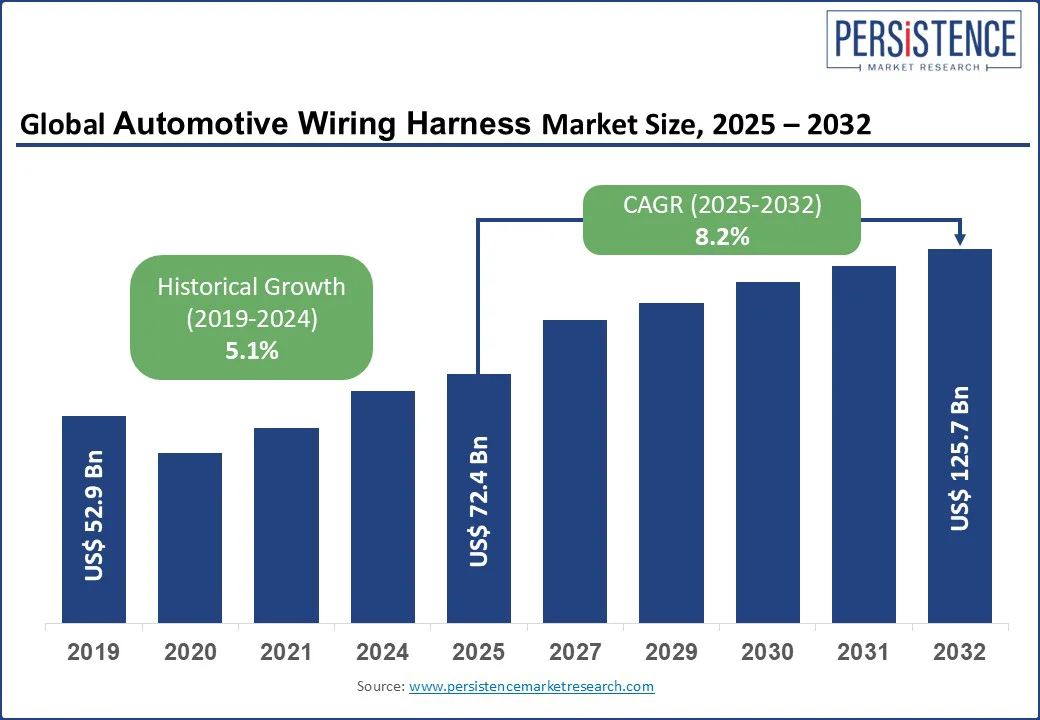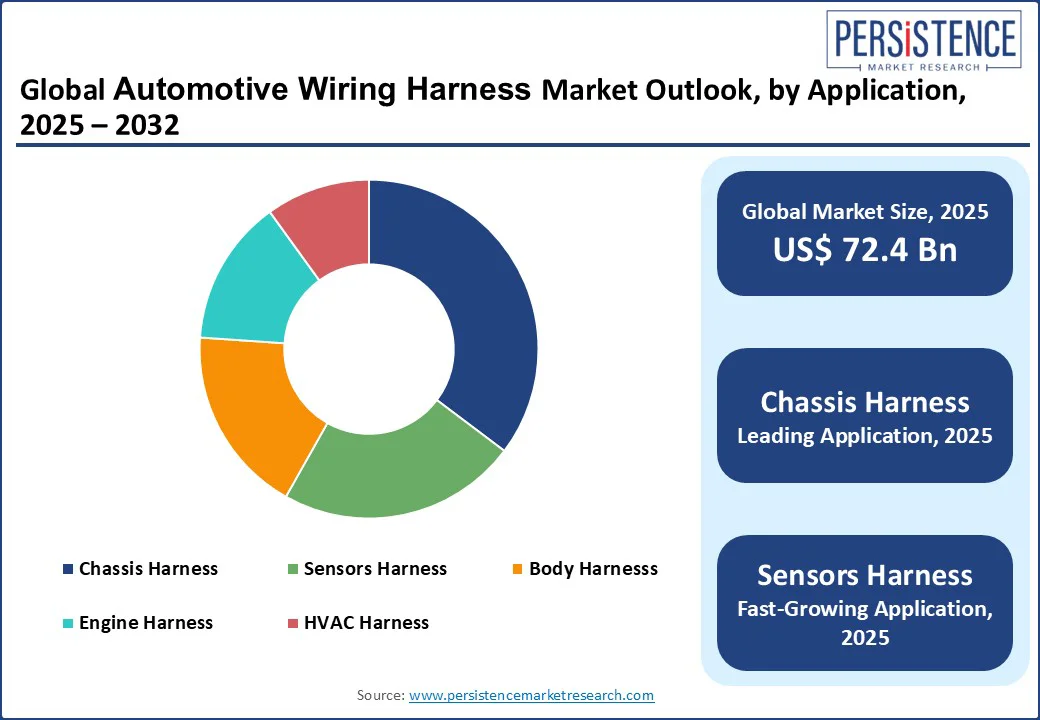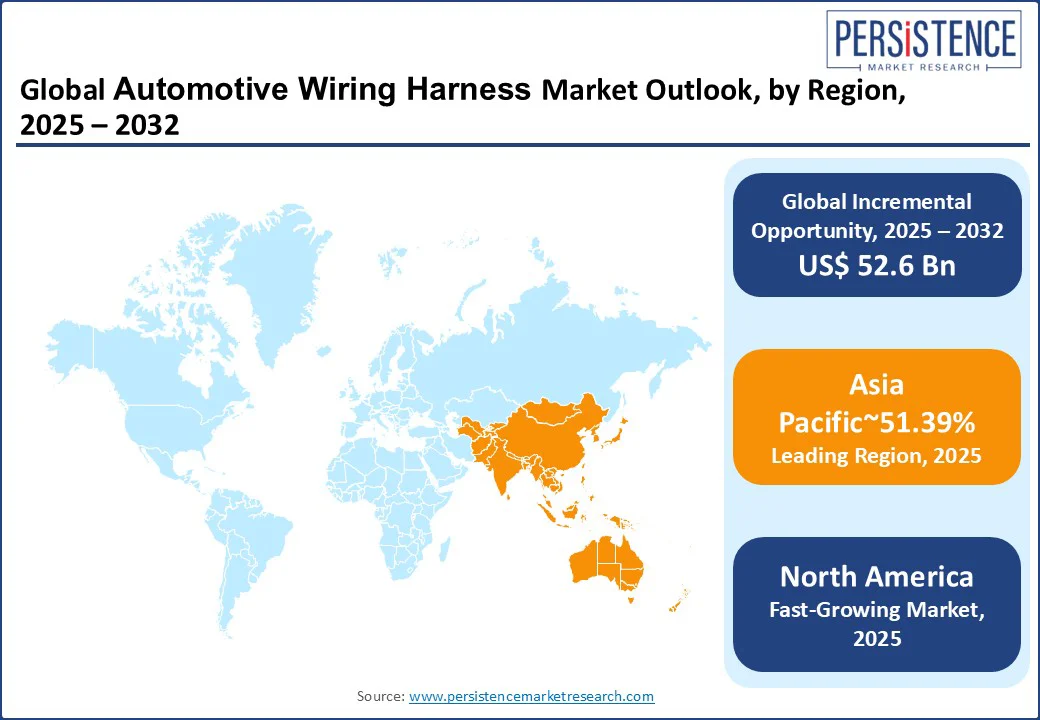ID: PMRREP3678| 190 Pages | 12 Aug 2025 | Format: PDF, Excel, PPT* | Automotive & Transportation

The global Automotive Wiring Harness market size is likely to value at US$ 72.4 Bn in 2025 and reach US$ 125.7 Bn by 2032, growing at a CAGR of 8.2% during the forecast period from 2025 to 2032. The market is experiencing robust growth, driven by increasing vehicle production, rising demand for advanced automotive electronics, and the shift toward electric and hybrid vehicles. Automotive wiring harnesses, critical for connecting electrical and electronic components, are essential for modern vehicles with complex systems such as ADAS, infotainment, and electric powertrains.

Key Industry Highlights:
|
Global Market Attribute |
Key Insights |
|
Automotive Wiring Harness Market Size (2025E) |
US$ 72.4 Bn |
|
Market Value Forecast (2032F) |
US$ 125.7 Bn |
|
Projected Growth (CAGR 2025 to 2032) |
8.2% |
|
Historical Market Growth (CAGR 2019 to 2024) |
5.1% |
The surging adoption of electric vehicles (EVs) and hybrid vehicles is a major driver of the global automotive wiring harness market. As governments worldwide implement stringent emission regulations, automakers are shifting toward battery electric vehicles (BEVs) and plug-in hybrid electric vehicles (PHEVs). According to the International Energy Agency (IEA), global EV sales reached 14 million units in 2023, with projections estimating 30% annual growth through 2030.
Wiring harnesses are critical for EV powertrains, battery management systems, and advanced electronics, driving demand for high-voltage and lightweight harnesses. In China, the world’s largest EV market, companies such as Yazaki Corporation and Sumitomo Electric Industries reported a sales increase in EV-specific harnesses in 2024. The integration of advanced driver-assistance systems (ADAS) and infotainment systems further amplifies the need for complex wiring solutions, ensuring sustained market growth through 2032.
High production costs and supply chain complexities pose significant challenges to the automotive wiring harness market, particularly for smaller manufacturers. The production of wiring harnesses involves labor-intensive processes and specialized materials, such as high-grade copper and insulation. These rising costs strain profit margins, especially for smaller players lacking economies of scale.
Additionally, global supply chain disruptions, such as semiconductor shortages and logistics bottlenecks, have escalated production delays and expenses. These challenges make it difficult for smaller manufacturers to compete with global leaders the Yazaki Corporation and Aptiv PLC, limiting market penetration in cost-sensitive regions. As a result, high costs and supply chain complexities continue to impede widespread adoption, particularly in emerging markets with underdeveloped industrial ecosystems.
The increasing focus on vehicle electrification and fuel efficiency is creating opportunities for lightweight and high-voltage wiring harnesses. Automakers are prioritizing weight reduction to enhance EV range and comply with emission standards, driving demand for advanced materials such as aluminum and fiber-optic harnesses.
The rise of high-voltage systems for EVs, particularly in Europe and North America, is also spurring innovation, with companies such as Furukawa Electric developing harnesses for 800V architectures. Government incentives, such as the EU’s Green Deal and the U.S. Inflation Reduction Act, are supporting investments in EV infrastructure, enabling manufacturers to tap into premiumization trends and expand market share through 2032.

Asia Pacific, holds approximately 51.39% market share in 2025 of the Automotive Wiring Harness Market, driven by high vehicle production and robust automotive supply chains in China, Japan, and India. China, the world’s largest automotive market, saw an increase in wiring harness demand in 2024, fueled by EV production from brands such as BYD and Tesla. Companies such as China Auto Electronics Group and Yazaki Corporation dominate, supported by government policies promoting EV adoption. India’s growing automotive sector, with players such as Spark Minda, is boosting demand for wiring harnesses, driven by rising vehicle exports and domestic consumption.
Europe is the fastest-growing region, propelled by stringent emission regulations, growing EV adoption, and investments in advanced automotive technologies. Germany and the UK lead, with companies such as Leoni AG and Kromberg & Schubert supplying high-voltage harnesses for EVs from automakers such as Volkswagen and BMW. The EU’s Green Deal, targeting carbon neutrality by 2050, supports investments in lightweight and high-voltage harnesses, with sales of EV-specific harnesses growing in 2024, driving market expansion.
North America, the second fastest-growing region, is driven by strong automotive manufacturing and EV adoption in the U.S. and Canada. Companies such as Aptiv PLC and Lear Corporation lead, supplying wiring harnesses for both ICE and EV applications. The U.S. Inflation Reduction Act, offering incentives for EV production, is boosting demand for high-voltage harnesses, with Tesla and GM driving sales growth in 2024. Urbanization and demand for advanced vehicle features further support market growth.

The Global Automotive Wiring Harness market is highly competitive, with global leaders such as Sumitomo Electric Industries, Yazaki Corporation, Aptiv PLC, and Leoni AG dominating through extensive product portfolios and global supply chains. Regional players such as China Auto Electronics Group and Spark Minda focus on localized manufacturing and cost-effective solutions. The rise of EV-specific and lightweight harnesses is intensifying competition, with companies investing in R&D and sustainable materials to enhance market share.
The Automotive Wiring Harness market is projected to reach US$ 72.4 Bn in 2025.
Rising demand for electric and hybrid vehicles and advanced automotive electronics is the key market driver.
The Automotive Wiring Harness market is poised to witness a CAGR of 8.2% from 2025 to 2032.
The growing adoption of lightweight and high-voltage wiring harnesses is the key market opportunity.
Sumitomo Electric Industries, Yazaki Corporation, Aptiv PLC, and Leoni AG are a few key market players.
|
Report Attribute |
Details |
|
Historical Data/Actuals |
2019 - 2024 |
|
Forecast Period |
2025 - 2032 |
|
Market Analysis Units |
Value: US$ Bn/Mn, Volume: As Applicable |
|
Geographical Coverage |
|
|
Segmental Coverage |
|
|
Competitive Analysis |
|
|
Report Highlights |
|
|
Customization and Pricing |
Available upon request |
By Component
By Application
By Propulsion Type
By Region
Delivery Timelines
For more information on this report and its delivery timelines please get in touch with our sales team.
About Author